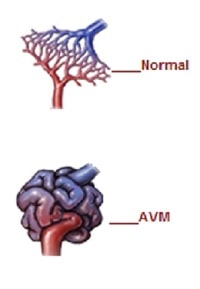Brain Arteriovenous Malformation, AVM
Brain Arteriovenous Malformation, AVM
It is defined as the tangling of arteries and veins in the brain due to the abnormal connection between them. Arteries supply the oxygenated blood to the brain and veins carries deoxygenated blood from the blood to the heart.
Symptoms
Signs and symptoms of brain AVM include:
- Weakness
- Numbness
- Paralysis
- Seizures
- Headache
- Confusion
- Vision loss
- Difficulty in speaking
Causes
The exact cause of AVM in brain is not known yet but it may be assumed that AVMs developed during growth of fetus. AVM bypassing the blood and causes mixing of oxygenated and deoxygenated blood and causes hypoxia which leads to ischemia of brain substance.
Complications
If left untreated it may cause the following complications:
- Hemorrhage due to the increase pressure in the arteries and veins which causes rapture of vessels.
- Ischemic injury due to low oxygen level due to the mixing of blood.
- Aneurysm
- Brain injury
Diagnosis
After taking history your doctor may conduct the physical examination to check the reflex and nervous system integrity and might recommend the followings test to confirm the diagnosis:
- Magnetic resonance imaging (MRI) to take the detailed image of your brain.
- Cerebral angiography to check the condition of your blood vessels in the brain.
- Blood test to check the complete blood count
- Lumber puncture to check the CSF pressure.
Treatment
There are many options of treatment available to treat brain AVM. The main aim of treatment is to decrease the risk of hemorrhage in the brain. Medication also use to reduce the signs and symptoms like headache and seizures.
Surgical options include:
- Endovascular embolization will help to reduce blood flow to the brain AVM and prevent the hemorrhage.
- Surgical excision of brain AVM.
- Radiation therapy to destroy the AVM through radiations.
